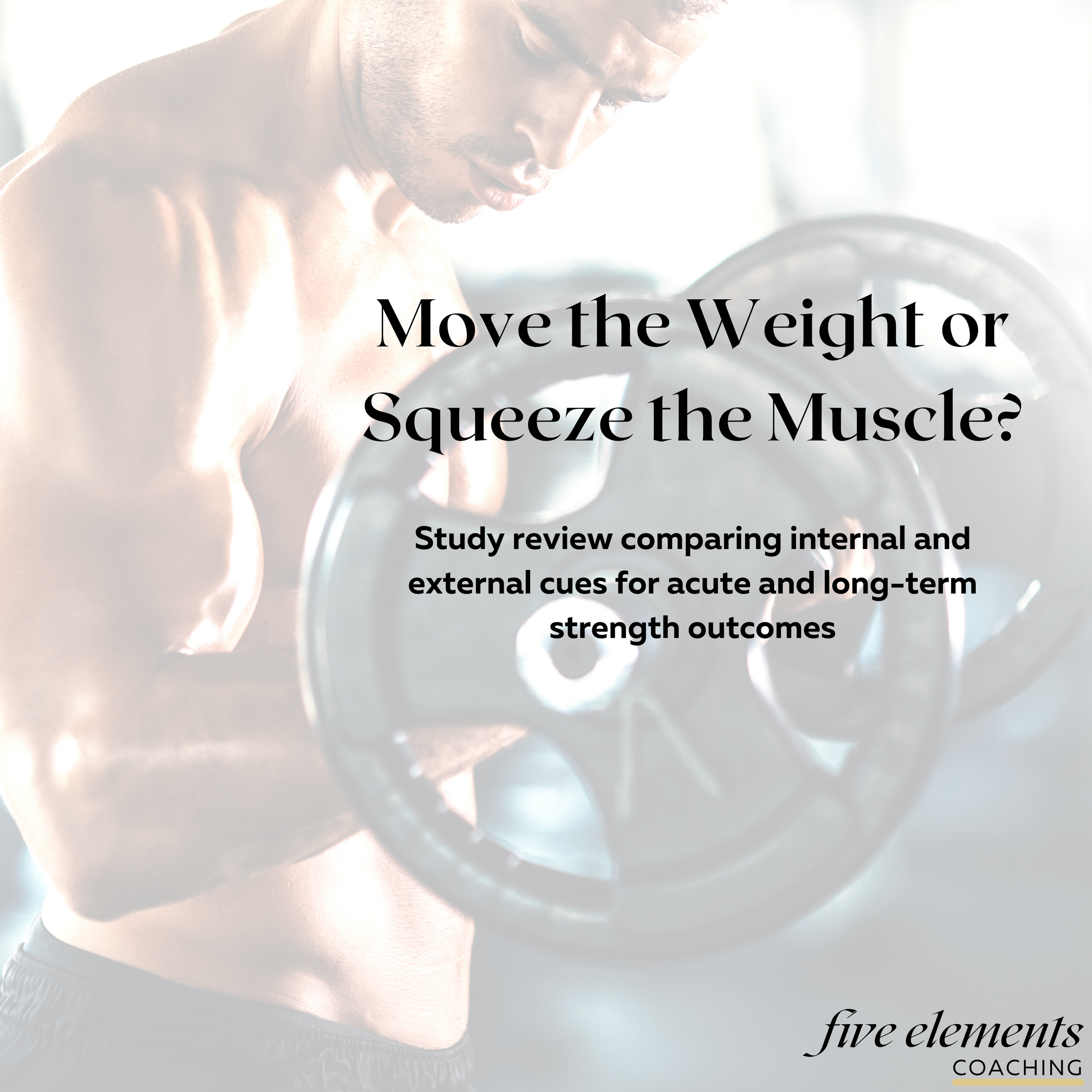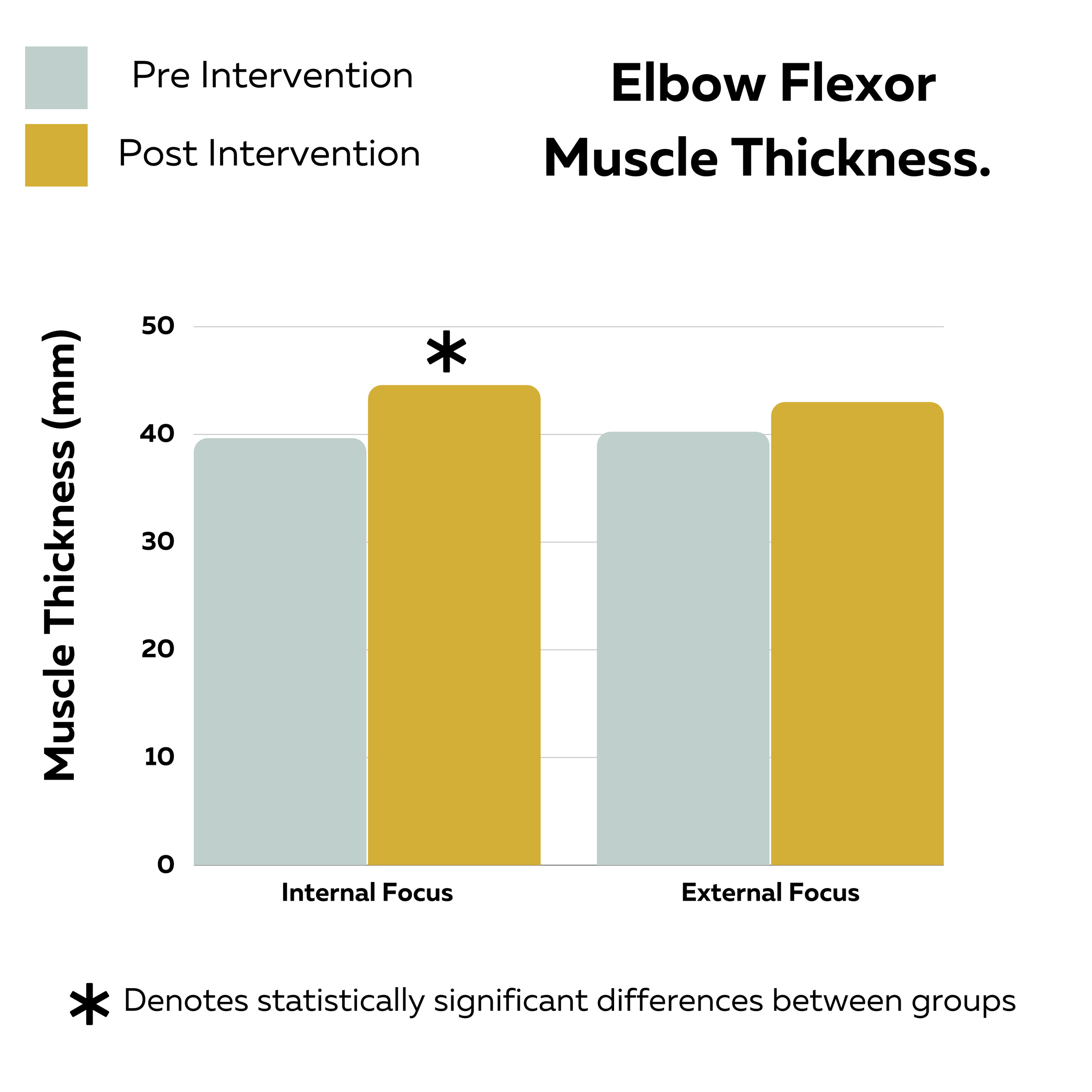Move the Weight or Squeeze the Muscle? Internal Vs. External Cues For Strength Gains
Meta-analysis review comparing internal and external cues for acute and long-term strength outcomes
Spark Notes
When it comes to developing motor skills, external cues tend to outperform internal cues.
This meta-analysis showed that external cues were better than internal cues for acute muscular strength outcomes.
For long-term muscular outcomes, external cues insignificantly performed better than internal cues, but when stratified to only lower body strength, external cues did significantly outperform internal cues.
One study did show that internal cues yielded better elbow flexor strength and a larger increase in muscle mass in the elbow flexors than external cues did. Showing that in some upper body isolation exercises, internal cuing may have the upper edge.
For all studies comparing compound lifts (squats/deadlifts were studied), external cues did consistently do better than internal cues.
Regardless, there is a time and place for both and whichever cues help you the most should still be prioritized.
When it comes to lifting and making gains, the cues we use during our favourite lifts can feel sacred.
Whether it’s “squeeze your bum cheeks” while doing a hip thrust, or “push the earth away from you” during a deadlift.
If a cue hits, It tends to stick, in my experience.
A cue is simply a verbal instruction to help you complete a given task with more efficacy. This makes the effectiveness of any cue, quite specific to the individual.
In the most simplest terms, if a cue works great for you, it’s because whatever lingo your coach or training partner was laying down, was being picked up nicely by you.
We’ve all been there when you’ve heard the same message a million times, but for some reason, the way it was phrased by someone on that particular day just made it just click.
This embodies how effective and unique any given cue can be to any individual.
With this is mind, there is research looking for which cues and types of cues tend to elicit better results in the context of strength training and skill acquisition.
This article will be going over some of that literature here but keep in mind, if you got cues that are paying off well for you, there is no need to change them if they aren’t in line with what research shows.
It may mean you could benefit from exploring new cues and types of cues, but you as you’ll see later, there is plenty of diversity when it comes to the findings.
This will be looking at internal cues and external cues.
Internal cues are when you focus more on what’s going on internally. Most commonly by focusing on a specific muscle. The example above of “squeeze your bum cheeks” is an internal cue.
External cues are when you focus on exerting force or focus externally. Most commonly on exerting force into an external object. The example of “push the earth away from you” is an external cue.
In strength training, a mix of both of these are used. As I will mention again, regardless of what the literature says, it’s not meant to be taken as one is inherently better or one should always be used. There is a time and place for both and it seems some times and some places may be better suited for one or the other.
So let’s get into it.
Study Reviewed: Acute and Long-Term Effects of Attentional Focus Strategies on Muscular Strength: A Meta-Analysis
This meta-analysis compiled data on 10 different studies that compared short term or long term strength outcomes from internal cues to external cues.
The strength measurements used were pretty diverse and included the following:
Hand grip strength test
Isometric mid thigh pull
Elbow flexion max voluntary contraction (MVC)
Index finger flexion (MVC)
Leg extension strength
Squat & Deadlift 1RM (RM= rep max)
Squat & Deadlift 10RM
The populations used were also diverse, but most were actually resistance trained or athletes. With 171 trained participants (men & women) and 57 untrained or non-specified participants (men & women).
Below, you can also see a list of the internal and external cues that were used within the more strength training specific studies.
All of the data was pooled and it was broken down into three forest plots to see if the pooled effect of the studies favoured one type of cue over the other.
1. Short term impact of external vs internal cues on muscular strength
Firstly, we’ll see that when it came to short term strength outcomes, the pooled effect favoured the external cues. The standardized mean difference was an effect size of 0.34 which was a “small” effect that favoured external cues. This effect was also statistically significant (which you can see because the confidence interval is completely on the right side of the Y axis).
Keep in mind this was only for short term outcomes — you’ll see only seven of the ten studies actually compared short term effects. Leaving three studies out of the first forest plot.
2. Long term impact of internal vs external cues for muscular strength
When the breakdown of studies that only looked at long term muscular strength was done, a slightly different story occurred.
The pooled effect still favoured external cues with a similar “small” effect size of 0.32. But, this was not statistically significant (as you’ll see the pooled effect confidence interval crossed the Y axis).
3. Long term impact of internal vs external cues for lower body muscular strength
Lastly, a subgroup for lower body muscular strength was done and once again, the pooled effect was in favour of external cues with a “small” effect size of 0.47. This also was statistically significant as you’ll see above.
When something is not statistically significant, it just means we can’t with as much confidence say our findings weren’t just due to random chance. The confidence interval that I mention above represents the range in where we can say the true average findings would be with 95% confidence. In other words, if we ran 20 studies with random samples, we’d expect 19 of the average findings to be on that line. When that confidence interval is completely on one side or another, we can say with more confidence that there is an effect of whichever intervention it favours.
Interpretations
When looking at all of this, it could be easy to wipe your hands clean and say external cues are the clear winner.
In which, I would say “not so fast.”
This wasn’t a particularly big meta-analysis. Especially when controlling for factors more applicable to strength training in a gym. Only three of the studies had actual training interventions and of those three studies, only the lower body muscular strength outcomes had statistically significant benefits in favour of external cues.
The meta at hand did mention that external cues are consistently shown to be better than internal cues for motor learning. This was also inline with the findings of the acute muscular strength forest plot above.
What was tricky, was that when looking at the three papers with training interventions, the Schoenfeld paper threw a big wrench in the findings.
The Schoenfeld paper was also the only one who measured actual muscle growth findings as well. In this paper, the internal focus actually has significantly better hypertrophy in the elbow flexors that the external focus group. With a 12.4 % increase in elbow flexor muscle thickness for the internal group compared to a 6.9% increase in elbow flexor muscle thickness for the external group.
Interestingly enough, there was no difference in muscle growth for the lower body muscles in either group in this study.
Elbow flexor strength had a statistically insignificant benefit with internal focus over external focus and lower body strength had a statistically insignificant benefit with external focus over internal focus. Which you can see reflected in the forest plots above.
One thing about this Schoenfeld paper though, is that the training intervention used a barbell curl. The reason why I bring this is up, is because if you’ve ever curled a free weight, you can imagine what may happen if you solely focused on the external cue of “get the weight up!”.
If you’re not following along, there is two potential issues with this:
The shoulders tend to help out a bit during the free weight barbell curl. When you’re gassed and trying to just get it up, you’ll often notice your upper arm start to flex too — which is going to be done mainly by your deltoid muscle.
There is essentially zero load on the biceps at the bottom of the lift. So if you tried to generate max force and speed from the bottom, the momentum you generate could help get you through the hardest part of the lift (which will be around the mid point), as well as making the part of the curl where the biceps are lengthened a bit easier — which could hinder hypertrophy outcomes.
This study did have certified trainers watching, so it’s not like they weren't monitored. Also, Brad Schoenfeld is a legend in the hypertrophy research space, so I’m also not trying to say he didn’t know what we was doing.
My main point is, the barbell curl exercise itself may uniquely be set up better for internal cuing than other exercises might. Especially when we’re assessing strength and hypertrophy of the elbow flexors specifically.
This could explain why the other two studies that compared elbow flexor MVC also showed short term benefits in favour of external cues. Since they didn’t use free weight curls to develop that strength. Rather, they were using constrained strength tests of the elbow flexors.
All in all, I’d say external cues do seem to be better on average for strength outcomes. With some obvious variance and individual strategies needed to be applied.
I’d say for your bigger and more complex movements, external cues seem to have an even bigger advantage, but in your isolation/simple exercises, internal cuing may also be of use — especially if you’re looking to grow your muscles.
Applications
If you’re looking to make more strength gains in your big lifts, I’ll give a general recommendation to use external cuing to do so.
I’ll give some lift specific external cues below.
Squat:
Drive your back into the bar as hard as you can
Drive your feet in the floor as hard as you can
Deadlift:
Grip the bar and leg press the earth away from you as hard as you can
Get stiff, drive your feet into the ground and pull the bar up as fast as you can
Bench Press:
Keep your arch and focus on pushing the bar up to the ceiling as hard as you can
Push your back into the pad and away from the bar as hard as you can
If you’re aiming to get stronger in these lifts or generally in more complex/compound lifts, from the research and from my experience, cues like this would probably be more effective for you than internal cues.
Now, when trying to isolate a muscle, internal cues can also come in handy. Especially when there are other muscles that could take over if you lose control.
One example being the biceps curl. The anterior deltoid can help take some load off the biceps by flexing the arm. In my experience, this is less likely to happen if you do have a more internalized cue guiding you.
One cue I like for biceps curls is “bring your forearm up to your bicep by flexing your biceps as hard as you can”.
This can also be useful for triceps extensions. As if you focus on the external too much, you may end up using your lats to extend your arms or even your abs to flex your trunk and gain more leverage.
When you focus on the external, your brain organizes to complete the task in the best way possible — which unfortunately doesn’t give a shit about you catching the gnarliest pump. In fact, if the ideal muscle you’d use to normally do so (the triceps in this situation) are gassed, your brain probably will start out sourcing the task to whatever other muscles can help in any way. This is where I can see internal cues being more helpful.
This external focus is beneficial when talking about more complex movements like the squat, deadlift or bench press. But may not be the best strategy for optimizing muscle growth with your isolation exercises.
Both cues have there places. As you’ve seen here, some cues just seem to be more effective than others in certain places. With that being said, if an internal cue is getting you crazy strength gains in your big lifts, keep given’er and vice versa.
I only hope this gives you more information to explore with new cues and try what works best for you. If you have no idea what works best for you, deferring to the findings in the relevant literature is always a great place to start.
Happy lifting.
Coach Dylan🍻
Click here to learn more about online coaching with us!
References:
Acute and Long-Term Effects of Attentional Focus Strategies on Muscular Strength: A Meta-Analysis
https://pubmed.ncbi.nlm.nih.gov/34822352/Attentional focus and motor learning: a review of 15 years
https://www.tandfonline.com/doi/abs/10.1080/1750984X.2012.723728Differential effects of attentional focus strategies during long-term resistance training
https://pubmed.ncbi.nlm.nih.gov/29533715/








